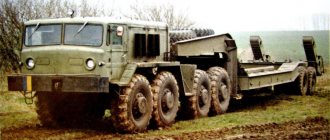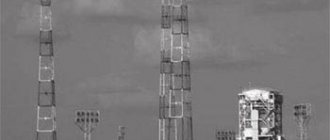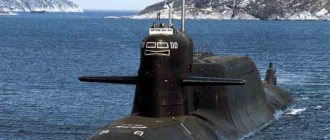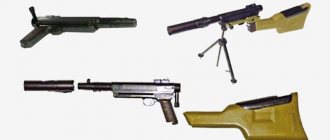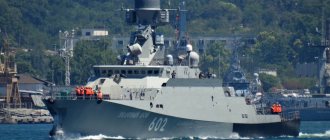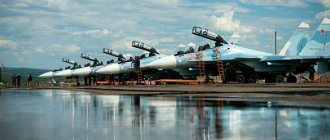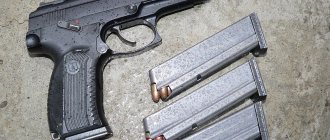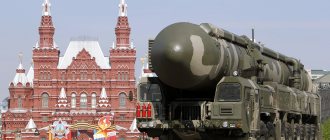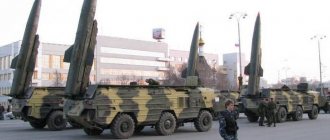Strategic Missile Forces
The Strategic Missile Forces or Strategic Missile Forces are a separate branch of the army in Russia and one of the most important, they consist of ground troops that control nuclear forces, they play an important strategic role.
This branch of the military is under the control of the General Staff and must always be ready for battle.
The missile force's arsenal includes ground-based intercontinental ballistic missiles, which can either be siloed or mobile.
In addition, these troops may also be equipped with nuclear missiles.
The history of missile forces in Russia begins with the USSR, where, after the end of World War II, they began to think about creating new branches of the military.
At first, only nuclear missiles were created, then they began to design controlled ballistic missiles, and entire formations were created to successfully work in order to quickly resolve emerging conflicts and solve important problems of protecting the state on a small scale.
Over time, everything just gained momentum, deployment began, permanent shifts on duty for intercontinental ballistic missiles appeared, who were ready to strike at any moment
Beginning in the late 1950s, mass production of missiles began, which made it necessary to reorganize the command structure, and thus the strategic missile forces appeared.
What do the Strategic Missile Forces consist of?
Structurally, the missile forces have not changed since the times of the USSR; they still consist of a missile army, which is divided into the same missile divisions and regiments.
For example, the 27th Guards Army of Vitebsk, which is controlled from Vladimir, has 5 missile divisions.
All components of the army are under the control of the main headquarters.
The most important location of the missile forces is in the Astrakhan region, namely at the Kapustin Yar training ground.
There is a missile testing site on the territory of Kazakhstan, it is called Sary-Shagan.
The center for scientific research and testing is located in Kamchatka, namely at the Kura training ground.
In addition to this, the missile forces also have:
- Central Institute for Research and Sciences No. 4;
- Academy training soldiers for the Peter the Great Rocket Forces;
- Military Institute of the Strategic Missile Forces in Serpukhov;
- Repair plants and storage bases;
- Airfields and heliports in the amount of 7 and 8 pieces;
- Engineering units that can do their job, camouflage missiles, clear the territory, build new paths;
Main goals
The Strategic Missile Forces (RVSN) are a branch of the Armed Forces of the Russian Federation (RF Armed Forces), the main component of its strategic nuclear forces (SNF).
Designed for nuclear deterrence of possible aggression and destruction as part of strategic nuclear forces or independently by massive, group or single nuclear missile strikes of strategic objects located in one or several strategic aerospace directions and forming the basis of the enemy’s military and military-economic potential.
What shells are in service with the Strategic Missile Forces?
There is not much weaponry, however, there is enough of it:
R-36M2
The R-36M2 is a liquid-based missile with 2 stages, capable of delivering 10 salvos at the enemy, they were actively distributed at the turn of 1980 and 1990, now they are still in their position. Also, this rocket has other names.
UR-100N UTTH
UR-100NUTTH is a liquid-based missile with 2 stages, it can fire 6 salvos, the active distribution of this weapon was at the turn of 1970 and 1980. They are still in use today.
Missiles of the Topol complex
The ground rocket of the Topol complex is a rocket that runs on solid fuel and has 3 stages, it delivers only 1 salvo, but it is very strong, these missiles were distributed from the mid-1980s to the beginning of the 1990s. Today, these missiles are being removed from service because their availability for use has expired.
Modified Topol-M missile system
The modified Topol-M rocket complex is a solid fuel rocket, it has 3 stages, and initially they only had 1 block.
This complex can operate both from mines and from ordinary land, while being mobile.
These are fairly new missiles; their implementation began in 2010.
Tajikistan
The Russian military base in Tajikistan serves the purpose of maintaining peace and stability in the region and ensures the national security of Tajikistan by serving as a deterrent to extremist Islamic groups operating in neighboring Afghanistan. The base is part of the Collective Rapid Deployment Force of the Central Asian Collective Security Region of the Collective Security Treaty Organization (CSTO). They were created on May 25, 2001 by decision of the heads of Russia, Kazakhstan, Kyrgyzstan and Tajikistan.
The Nurek optical-electronic node, part of the Russian Space Control System, provides control over space objects. Due to the geographical location of the node, every spacecraft launched from any test site in the world into an orbit with an altitude of more than 2000 km, on the very first orbits, ends up in the area of responsibility of the Okno-M optical-electronic complex (OEC) installed there. The location of the node was also chosen taking into account the optical transparency and stability of the atmosphere and the number of clear night hours (about 1500 per year).
In 1992-2005 Russian border guards were responsible for guarding the Tajik-Afghan border. They were withdrawn from Tajikistan on July 13, 2005, and since then the protection of the country’s southern borders has been entirely carried out by Tajik border guards.
The Border Cooperation Group of the FSB of Russia in the Republic of Tajikistan remains in Tajikistan, providing the republic with methodological and advisory assistance in organizing and implementing state border protection.
201st Gatchina Order of Zhukov twice Red Banner military base
Russian troops at the 201st Gatchina Order of Zhukov twice Red Banner military base. Source: vse42.ru.
The 201st base was formed by Decree of the President of the Russian Federation No. 1055 of September 5, 2005 on the basis of the 201st motorized rifle Gatchina twice Red Banner motorized rifle division (MSD). The 201st Division was stationed in Tajikistan from 1945-1980. In 1980-1989 The division took part in the war in Afghanistan, after which it returned to Tajikistan. By the Decree of the President of the Russian Federation dated September 9, 1992 “On the transfer to the jurisdiction of Russia of military formations located on the territory of the Republic of Tajikistan”, by order of the Minister of Defense of the Russian Federation dated September 22, 1992 No. 47, units of the 201st Motorized Rifle Division in full force were included in the Land Russian troops.
In 2010, based on the directive of the Chief of the General Staff of the Armed Forces of the Russian Federation, the 201st Gatchina twice Red Banner military base was transferred to a brigade structure. On October 3, 2012, for the successful completion of military tasks and the courage and heroism shown by the personnel, the base was awarded the Order of Zhukov. In 2014, based on the directive of the Chief of the General Staff of the Armed Forces of the Russian Federation, the 201st military base was again transferred to a divisional structure.
By 2022, the number of personnel at the base is planned to increase to 9,000 people. The base is Russia's largest land base abroad. It is part of the Central Military District (headquarters in Yekaterinburg).
Until recently, the 201st base was stationed in three garrisons: in the cities of Dushanbe, Kurgan-Tube (191st Motorized Rifle Narva Red Banner, Order of Alexander Nevsky Regiment) and Kulyab (149th Guards Motorized Rifle Czestochowa Red Banner, Order of the Red Star Regiment). In 2015, the 149th Guards Motorized Rifle Regiment was redeployed from Kulyab to Dushanbe and to the Lyaur training ground, 25 km south of Dushanbe. The base also includes an air group (4 Mi-24P helicopters and 4 MI-8MTV helicopters), based at the Ayni military airfield (15 km west of Dushanbe)[5]. For combat training, three of its own training grounds are used - Lyaur, Momirak and Sambuli.
Mi-24P helicopter. Source: karopka.ru.
The number of personnel at the base, according to The Military Balance 2017, is 5,000 people. Its ground units are armed with 40 T-72B1 tanks, 60 BMP-2 infantry fighting vehicles, 80 BTR-82A armored personnel carriers, 40 MT-LB light armored multi-purpose transporters, 18 122-mm 2S1 Gvozdika self-propelled howitzers, 36 152-mm self-propelled howitzers 2S3 "Akatsiya", 6 120-mm mortars 2S12 "Sani", 12 multiple launch rocket systems 9P140 "Uragan"[6].
The Russian base operates on the basis of the Agreement between the Russian Federation and the Republic of Tajikistan on the status and conditions of the Russian military base on the territory of the Republic of Tajikistan, signed on October 5, 2012. It replaced the agreement on the status of the Russian military base in Tajikistan dated April 16, 1999, which expired in October 2014. According to the new Agreement, during the period of its validity, Russia uses real estate that is the property of the Republic of Tajikistan and transferred for temporary use to accommodate a Russian military base. The ownership of real estate acquired and (or) constructed on the territory of the Republic of Tajikistan after May 25, 1993 at the expense of the Russian Federation is recognized by Russia. Movable property delivered to military units of a Russian military base after May 25, 1993 is the property of the Russian Federation. The Agreement is concluded for a period of 49 years and is automatically extended for subsequent 5-year periods unless either Party, no later than one year before the expiration of the initial or any subsequent period of its validity, sends written notice to the other Party of its intention to terminate it.
Separate optical-electronic unit "Nurek" (Optical-electronic complex "Window")
Separate optical-electronic unit "Nurek". Source: vpk-news.ru.
The optical-electronic node "Nurek" of the space control system is located at an altitude of 2216 m above sea level in the Sanglok (Pamir) mountains, near the city of Nurek in the Khojarki village area.
Several hundred Russian military personnel - officers and contract soldiers - serve at the site. They are there on daily combat duty, living on the territory of a military camp in Nurek.
The node is equipped with an optical-electronic complex (OEC) “Okno-M” (“Optical control of the celestial region”), which, using powerful telescopes, provides control of outer space at altitudes from 2 to 50 thousand km from the Earth, detecting space objects at night by reflected them to sunlight.
The resulting optical information is then converted into electrical information. This allows, using computer technology, to automatically determine the parameters of an object (coordinates, velocity vector, brightness, class, purpose and current state) using certain algorithms [7]. The processed information is then transmitted to higher command posts. The complex is capable of accompanying low-orbit space objects with flight altitudes from 120 to 2000 km (according to received target designations).
Construction of the UEC began back in 1979, but due to technical difficulties, the collapse of the USSR and the civil war in Tajikistan, it was greatly delayed. The complex was put into trial operation only on November 19, 1999. A minority of the ten substations of the complex began combat duty on March 16, 2004.[8] State tests of the full complex were completed in November 2014, and in 2015 it began performing space control tasks.
According to the Agreement between the Government of the Russian Federation and the Government of the Republic of Tajikistan on the transfer to the ownership of the Russian Federation of the optical-electronic node "Nurek" of the space control system and the procedure for its operation dated October 16, 2004, the "Nurek" node was transferred to the ownership of the Russian Federation in repayment of part of the debt The Republic of Tajikistan to the Russian Federation on state loans.
How is the Strategic Missile Forces developing?
To begin with, it should be said that today our country does not have the ability to completely control the Atlantic and Pacific oceans, since most of the intercontinental ballistic missiles have long since become unusable.
Today there is a need to improve old and create new missiles, but reforms still continue.
Some countries that have achieved an alliance with each other can better control the necessary areas.
The state of the Russian economy today makes it possible for the missile forces to occupy the most important role in the army, which will help them protect us from a possible invasion by a potential enemy.
However, among some unpreparedness, there are also advantages: now new facilities are being introduced throughout the country to prevent missile attacks, and satellites are being launched into space, which can also prevent the presence of attacks from the enemy.
The number of complexes and missiles is not decreasing, it’s just that old and unusable models are being retired, and the brand new Topol-M and Yars complexes are entering service.
However, there is a new problem: new products in the field of missiles and complexes require maintenance, and it must be modern.
Military registration and enlistment offices and training institutions have ideas about what kind of people should be recruited into the army.
All those who are junior military personnel or have recently entered service have certain requirements that imply a certain education, namely technical education.
Here is what else is needed for the development of missile forces; all this is now actively being developed:
- The ability to maintain combat readiness for all necessary armies;
- Increasing the shelf life of missiles to the maximum;
- Quick location of the newest Topol-M complex, which can be either stationary or mobile;
- Improved command, direction and control of soldiers and equipment;
- Improving the technical component of rockets for better performance;
Day of the Strategic Missile Forces of the Russian Armed Forces
Every year on December 17, Russia celebrates a memorable date - the Day of Strategic Missile Forces (Strategic Missile Forces). They were formed in 1959.
On December 17, 1959, a resolution was issued by the Council of Ministers of the USSR, according to which the post of Commander-in-Chief of the Missile Forces was established in the structure of the armed forces, the Main Headquarters of the Strategic Missile Forces was formed, as well as other military command and control bodies. Until 1995, Strategic Missile Forces Day was celebrated in Russia on November 19 as part of the “Rocket Forces and Artillery Day”.
Nowadays, this is a separate memorable date and professional holiday for all military personnel and civilian personnel of the Ministry of Defense related to the strategic missile forces.

